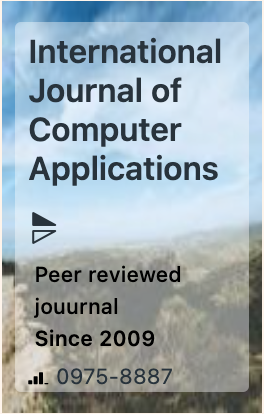The week's pick
Random Articles
Reseach Article
Classifying the Severity of Cyberbully from Social Media Comments
| International Journal of Computer Applications |
| Foundation of Computer Science (FCS), NY, USA |
| Volume 186 - Number 63 |
| Year of Publication: 2025 |
| Authors: Makkala Nokham, Bandhita Plubin, Walaithip Bunyatisai, Thanasak Mouktonglang, Suwika Plubin |
 10.5120/ijca2025924448
10.5120/ijca2025924448
|
Makkala Nokham, Bandhita Plubin, Walaithip Bunyatisai, Thanasak Mouktonglang, Suwika Plubin . Classifying the Severity of Cyberbully from Social Media Comments. International Journal of Computer Applications. 186, 63 ( Jan 2025), 34-42. DOI=10.5120/ijca2025924448
Abstract
The proliferating omnipresence of cyberbullying on digital social networks has crystallized into a pressing societal dilemma, exacting substantial emotional and psychological tolls on affected individuals. Traditional methodologies for identifying and combating cyberbullying are hindered by the expansive scope and multifaceted complexity of digital content. This paper explores the utilization of emerging machine learning technologies and sophisticated natural language processing approaches to automate the detection and classification of cyberbullying within social media contexts. Specifically, the study applies Bidirectional Encoder Representations from Transformers (BERT), Naïve Bayes (NB), and Support Vector Machine (SVM) frameworks to systematically classify user-generated comments into non-cyberbullying and distinct tiers of cyberbullying severity, specifically Low, Middle, and High Severity. The dataset consists of 13,204 comments from platforms like Facebook, X (formerly Twitter), and TikTok. The results demonstrate that the SVM model surpasses the performance of its counterparts, achieving a remarkable accuracy of 94% and an F1-Score of 0.95 in binary classification. BERT also demonstrated strong performance, particularly in multi-level severity classification, while NB showed the lowest performance. Stacking also exhibited strong performance, particularly in detecting High Severity Cyberbullying. While NB and BERT performed well, especially in binary classification, they were less consistent in the multi-level severity classification. The findings highlight the effectiveness of SVM for detecting cyberbullying severity, offering valuable insights for future automated moderation and content classification systems.
References
- Daopradub, P. (2017). The influence of social media on communication and interaction. Research article.
- Dinakar, K., Reichart, R., & Lieberman, H. (2011). Modeling the detection of textual cyberbullying. In Proceedings of the Fifth International Conference on Weblogs and Social Media (ICWSM-11).
- Hee, W. L., Tan, S. P., & Tay, A. A. (2015). The psychological effects of cyberbullying on adolescents. Journal of Youth and Adolescence, 44(2), 235–246. https://doi.org/10.1007/s10964-014-0117-0
- Big Data Thailand. (2022). Machine learning and natural language processing for analyzing online behavior. Report.
- Thananukhun, K., et al. (2023). Question classification for Thai conversational chatbots using artificial neural networks (ANN) and multilingual BERT. In Proceedings of the International Conference on Natural Language Processing and Computational Linguistics.
- Shivani, S., et al. (2022). Comparison of SVM and Naïve Bayes for sentiment classification using BERT embeddings. International Journal of Computer Applications, 179(10), 44–52. https://doi.org/10.5120/ijca2022921443
- Kusumawati, S., et al. (2019). Comparing the performance of Naïve Bayes and SVM for Tokopedia's Twitter service classification. Indonesian Journal of Computer Science, 11(2), 101–109. https://doi.org/10.11591/ijcs.v11i2.22679
- Venkataramana, V., et al. (2022). COVID-19 sentiment classification using BERT and other machine learning models. International Journal of Data Science and Machine Learning, 6(3), 213–225. https://doi.org/10.11648/j.ijdsm.20220603.15
- Tian, Y., et al. (2021). Fake news detection using machine learning and deep learning models. IEEE Transactions on Information Forensics and Security, 17(1), 204–215. https://doi.org/10.1109/TIFS.2021.3081124
- Devlin, J., Chang, M. W., Lee, K., & Toutanova, K. (2019). BERT: Pre-training of deep bidirectional transformers for language understanding. Proceedings of NAACL-HLT 2019, 4171–4186. https://doi.org/10.18653/v1/N19-1423
- Vaswani, A., Shazeer, N., Parmar, N., Uszkoreit, J., Jones, L., Gomez, A. A., Kaiser, Ł., & Polosukhin, I. (2017). Attention is all you need. In Advances in neural information processing systems (NeurIPS 2017) (pp. 5998-6008).
- Hassan, S., Rafi, M., & Shaikh, M. S. (2011). Comparing SVM and naïve Bayes classifiers for text categorization with Wikitology as knowledge enrichment. In Proceedings of the 2011 IEEE 14th International Multitopic Conference (pp. 31–34). IEEE. https://doi.org/10.1109/INMIC.2011.6143977
- Dumais, S. T., Osuna, E., Platt, J., & Scholkopf, B. (1998). Support vector machines. IEEE Intelligent Systems and Their Applications, 18–28. https://doi.org/10.1109/5254.708791
- Wolpert, D. H. (1992). Stacked generalization. Neural Networks, 5(2), 241-259. https://doi.org/10.1016/S0893-6080(05)80023-1.
Index Terms
Keywords

